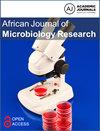Microbiological, nutritional and sensory evaluation of snack bars developed using Bambara groundnut (Vigna subterranean L.) and maize (Zea mays)
引用次数: 3
Abstract
Over the years, snacking has become a regular habit for majority of the population with increasing need for food manufacturers to meet consumers’ demand through product development. In this study, snack bars were prepared using maize and Bambara nuts mixed in the following ratios: A, 100% maize; B, 100% Bambara nuts; C, 50% maize: 50% Bambara nuts; D, 75% maize: 25% Bambara nuts; E, 75% Bambara nuts: 25% maize. The total heterotrophic bacterial count of samples A to E was within the limit stipulated by International Commission on Microbiological Specification for Food. The frequency of occurrence of bacterial isolates from the samples include Bacillus species (24%), Staphylococcus species (24%), Lactobacillus species (24%), Escherichia coli (19%) and Serratia species (9%), while the fungal isolates include Aspergillus (33%), Penicillium (27%), Rhizopus (20%) and Saccharomyces species (20%). The moisture, ash, carbohydrate, crude protein, fat and fiber content of the samples were within the range of 11.47±0.99-17.45±1.01, 1.09±0.07-2.00±0.15, 56.05±0.65-70.37±0.71, 6.32±0.36-15.00±0.22, 4.60±0.50-7.00±0.30 and 2.60±0.25-3.10±0.31%, respectively. There was a significant difference (p<0.05) in the proximate composition among the samples except for crude fiber. The calorie value range between 347.20-367.69 kcal and acceptability of the samples compared favourably with a commercialized snack bar.使用班巴拉花生(Vigna underground L.)和玉米(Zea mays)开发的小吃店的微生物学、营养和感官评估
多年来,随着食品制造商越来越需要通过产品开发来满足消费者的需求,吃零食已成为大多数人的常规习惯。在这项研究中,小吃店是用玉米和班巴拉坚果按以下比例混合而成的:A,100%玉米;B、 100%班巴拉坚果;C、 50%玉米:50%班巴拉坚果;D、 75%的玉米:25%的班巴拉坚果;E、 75%的班巴拉坚果:25%的玉米。样品A至E的异养细菌总数在国际食品微生物规范委员会规定的限度内。从样品中分离出的细菌的出现频率包括芽孢杆菌(24%)、葡萄球菌(24%),乳酸杆菌(24%,大肠杆菌(19%)和沙雷氏菌(9%),而真菌分离物包括曲霉(33%)、青霉(27%)、根霉(20%)和酵母(20%)。样品的水分、灰分、碳水化合物、粗蛋白、脂肪和纤维含量分别在11.47±0.99-17.45±1.01、1.09±0.07-2.00±0.15、56.05±0.65-70.37±0.71、6.32±0.36-15.00±0.22、4.60±0.50-7.00±0.30和2.60±0.25-3.10±0.31%的范围内。除粗纤维外,各样品的近似成分差异显著(p<0.05)。热量值在347.20-367.69千卡之间,与商业化的小吃店相比,样品的可接受性良好。
本文章由计算机程序翻译,如有差异,请以英文原文为准。
求助全文
约1分钟内获得全文
求助全文

 求助内容:
求助内容: 应助结果提醒方式:
应助结果提醒方式:


